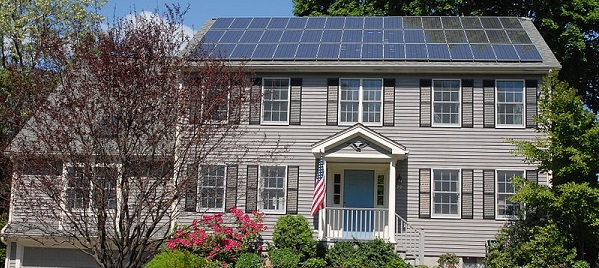By many accounts, the spread of solar power is unstoppable. Costs continue to fall at a blistering pace, solutions to give consumers a solar-powered home without needing to connect to the grid for back-up power are emerging, and even the U.S. Supreme Court has weighed in, with a recent ruling that is favorable for the solar energy market.
Seen another way, though, solar power is seeing serious threats.
Predictions from even last year were that solar energy would soon match the price of electricity from utilities – known as “grid parity” in the business. But the plummeting cost of natural gas, which has become the most used fuel to generate power, has kept electricity prices low. And after dropping precipitously for several years in a row, solar panel prices have recently leveled off, making grid parity more elusive.
Solar businesses are feeling some of this market instability. First Solar, a large manufacturer of solar panels, has seen its stock price gyrate up and down over the past several months, while the stock price for Solar City, a large installer of solar panels, has dropped nearly 50% since its high in December.
And now, electric utilities are pushing back against solar – with some success. In late 2015, the state of Nevada more than tripled a monthly fee customers need to pay on rooftop solar projects. A last-minute appeal in early January failed, and Solar City laid off hundreds of workers and saw its stock price plummet within the space of a few weeks.
The battle between the solar industry and electric utilities has the makings of a classic David versus Goliath tale, but the debate raises legitimate questions, notably: how should regulations be updated to recognize the growth of solar while still ensuring a reliable and affordable power system? And ultimately what value do distributed solar and utilities provide to society?
Solar: friend or foe to the grid?
Any part of the energy business is going to be volatile at times (just ask any shell-shocked oil executive). But the situation being faced by the solar industry is different, because the industry’s success and failure depend as much on a complex web of state and federal regulations as on genuine technological progress.
Many of these regulations were designed to provide a stable environment for electric utilities, and to promote reliable electricity supplies, by keeping the utility shielded from competition. Utilities are feeling threatened by solar energy upstarts, which effectively turn customers into competitors, and are leaning on those regulations to fight back.
Nevada changed electric billing to allow utilities to triple the monthly charges for people who own solar panels – one of a few state-level battles between utilities and solar providers.
In some places, those fights have not ended well for the solar industry. Nevada and Arizona states have imposed fees on rooftop solar power. In California, the state has resisted the types of fees assessed in Arizona and Nevada, but has also changed the incentives for rooftop solar to limit the amount of excess power – those times when solar panels produce more power than a building consumes – that flows back to the grid.
The whole fight revolves around a seemingly simple question: is rooftop solar power good for the grid, or bad for the grid?
Two sides to every solar panel
While the question seems innocuous, there isn’t a very simple answer. There are basically two sides to the debate.
On the one hand, more rooftop solar power lowers the amount of power needed from centralized power plants. That means upgrades to the grid – such as new power plants or bigger power lines and substations – can be delayed or even canceled altogether. Utilities and their regulators, even those opposing the expansion of rooftop solar power, have long recognized the value of lowering demand.
Rooftop solar would seem particularly valuable in this regard since it can be set up to produce more energy during the afternoon peak, when demand is most expensive to meet and the risk of blackouts is the highest.
Utilities argue that if more consumers use solar to lower their monthly bills, there are fewer funds to pay for maintenance of the power grid.
On the other hand, the legacy grid and the goal of providing reliable electricity to society are not simply going away. A utility needs to bring in enough revenue to pay for the grid and to support social programs like providing low rates for poor customers.
Also, utilities have a responsibility to make sure there is enough electricity to meet consumers’ demand at all times. Having more customers generate their own solar power (and selling some back to the grid) makes the job of utilities more complicated, because it is harder to predict how much power the grid will demand at any given time.
An argument made in solar-friendly California (captured by the infamous “duck curve”) was that large amounts of rooftop solar would actually increase the cost of maintaining a reliable grid, because a utility would need new power plants to handle the rapid increase in the demand for grid power after the sun goes down.
Each of these arguments has some merit. Power grid operators in some parts of the country have found that reducing demand for electricity from the grid can reduce costs and prevent blackouts. California has enacted some reforms to its electricity system to create incentives for the types of supplies that could keep the grid balanced when solar production swings unpredictably. These reforms will encourage new technologies, but will probably also increase the costs of grid-provided power.
Existential questions
An even thornier question that California is wrestling with is the scope of a utility itself.
If solar power achieves the magic point of grid parity, then what is left for the utility to do? How long can the existing power grid work its way around customers who install their own solar power and battery systems, thus cutting the cord to their utility altogether?
Maintaining the grid requires money, which ultimately comes from electricity users. Who will be left to pay for the grid as more people cut their ties with utilities? What does that mean for electricity access for poor people in particular?
Some states, including California, New York and Vermont, are proactively thinking about the overall place of the utility and a sustainable business model in a world of solar grid parity. These states are starting to view utilities as service providers, rather than just kilowatt merchants.
States like Arizona and Nevada are, for better or worse, effectively kicking the can down the road. Sooner or later the moment of grid parity is likely to arrive, where cutting the cord to the grid is economical even without any subsidies. That will force a major conversation about the utility business and how to best ensure reliable access to low-cost electric power.
Reference:
This article has been published here by the PVbuzz team from the original article written by Seth Blumsack and published on The Conversation.
Seth Blumsack receives funding from the National Science Foundation, Department of Energy, Environmental Protection Agency, Commonwealth of Pennsylvania, and electric utility and natural gas pipeline companies. He serves as an advisor for the Microgrid Systems Laboratory.














Comments